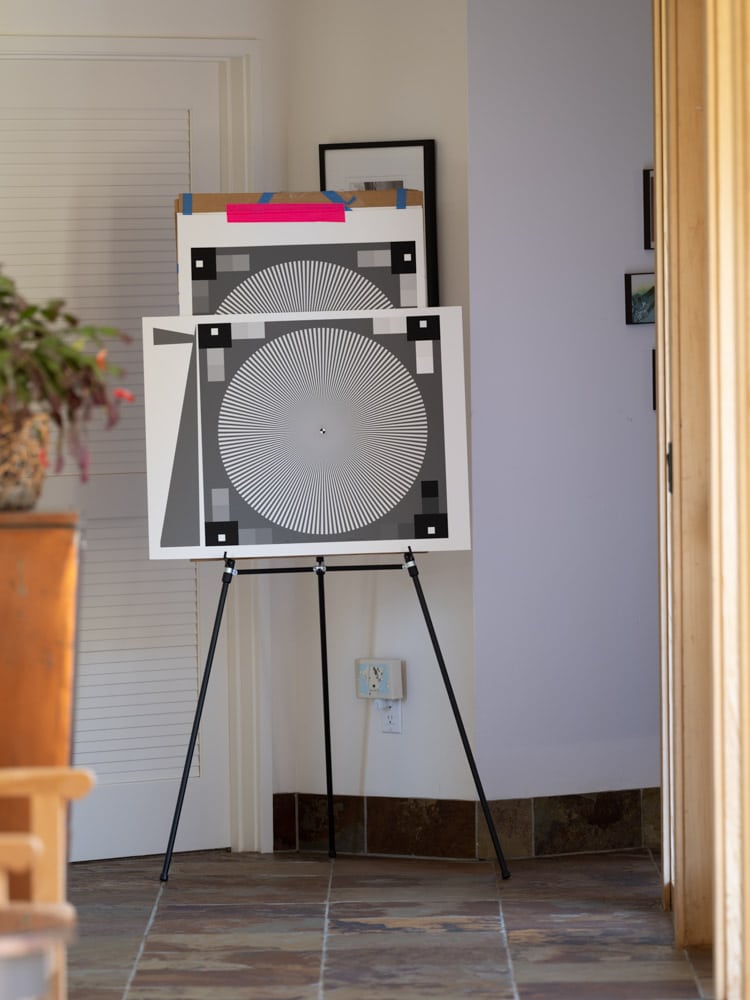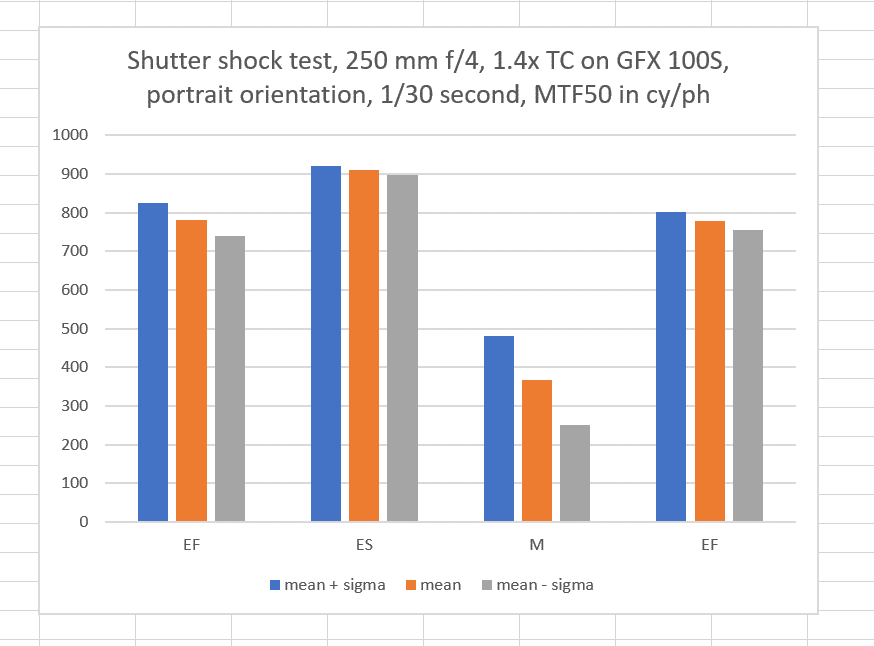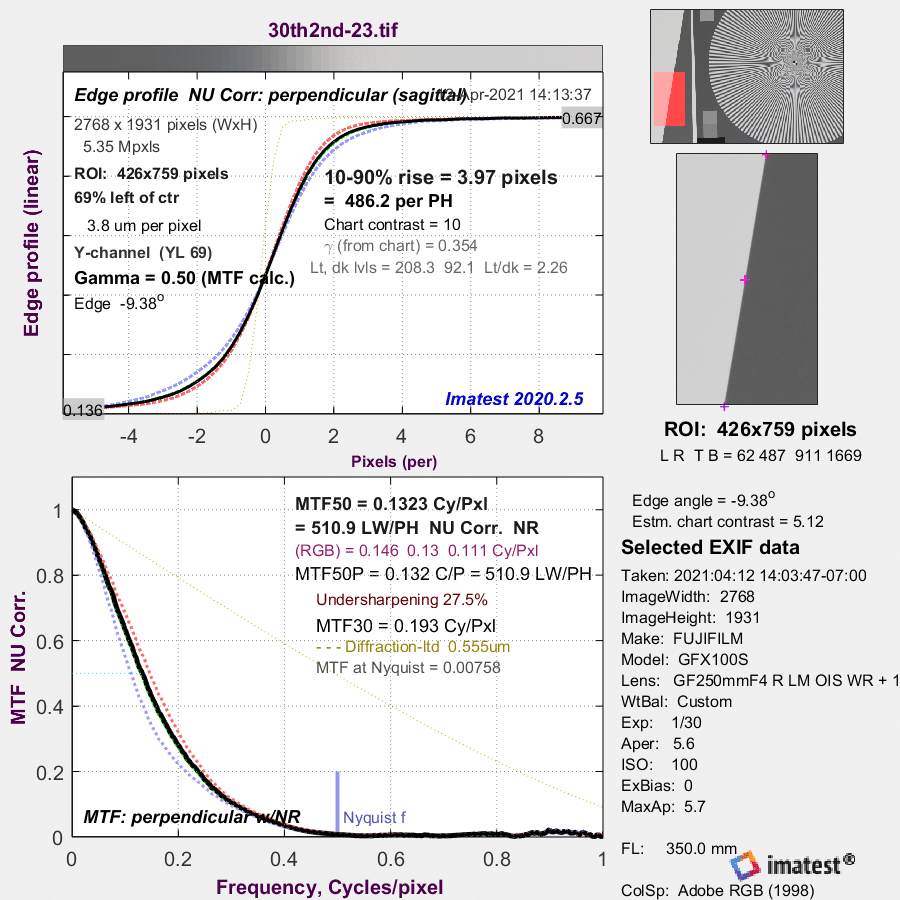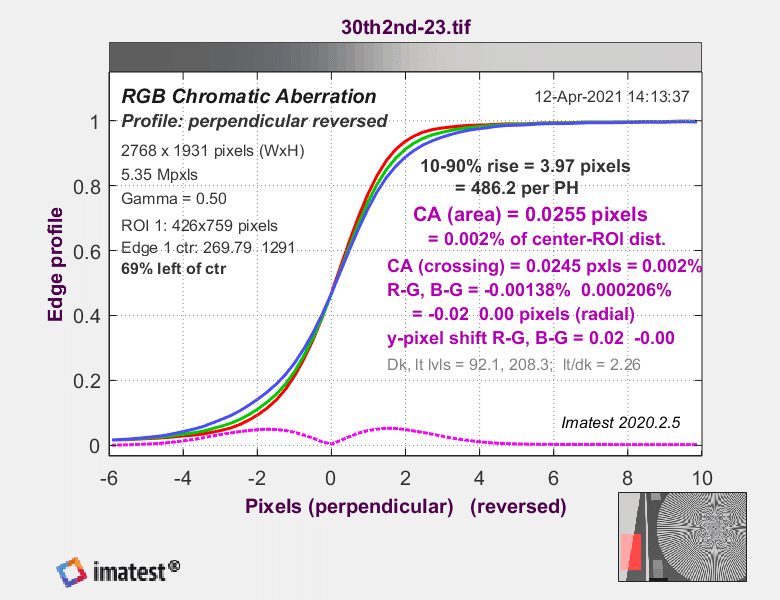This is one in a series of posts on the Fujifilm GFX 100S. You should be able to find all the posts about that camera in the Category List on the right sidebar, below the Articles widget. There’s a drop-down menu there that you can use to get to all the posts in this series; just look for “GFX 100S”.
On DPR, someone posted some anecdotal photographs that suggested that with long lenses, shutter shock on the GFX 100 was lower _ I almost said significantly lower, but then again it was an uncontrolled, low-N test so it’s hard to ascribe significance. I realized that I hadn’t done much at all with shutter shock on the GFX 100xs cameras, figuring, as is the case with the GFX 50S, that electronic first curtain shutter (EFCS, or, in Fuji’s notation, EF) pretty much made shutter shock not worthy worrying about.
I decided to construct a close-to-worst-case test. I took the following gear:
- GFX 100S
- Fuji 250 mm f/4 lens
- Fuji 1.4X teleconverter
- C1 cube
- RRS 4-series carbon fiber legs
And set it up in portrait orientation, which is the worst case for the GFX shutter, which travels in the short direction.
Here’s the target:
My indicator of sharpness is the vertical slanted edge on the left. Using an edge that runs parallel to the long side of the sensor is again a worst-case situation. If focus error with AF-S is smaller than the shutter shock variations that we’re looking for, using AF to focus each frame would be the way to go here, to avoid any change of the infamous Fuji GFX focus drift issue. I ran a test. focus variation with AF-S was far greater than the kinds of differences I expected to see between the electronic shutter (ES) and EFCS.
Darn. I need to use manual focusing. I focused once at the beginning of the series.
I decided to shoot 16 shots in each of ES, EFCS, and mechanical shutter, with the lens wide open, giving my f/5.6. I did the EFCS series first, with the shutter actuations 2 seconds apart. I picked a shutter speed of 1/30 second, which is close to the worst case for this kind of test,
I developed the images as follows:
- Lightroom 10.2
- Default settings except as noted below
- Sharpening turned off
- White balanced to gray of slanted edge.
I analysed the slanted edge with Imatest, looking for the MTF50.
The results:
Why are there two EF (or EFCS) datasets? That’s my way of checking for focus drift. The order of testing was EF, ES, M, and EF again at the end. YOu can see that the EF bookends provide essentially the same results, which indicates to me that there was no material focus drift.
ES wins. Why? It could be that it’s better in isolation, or it could be that the 2 seconds between shots wasn’t enough time for the vibrations to die down. I ran another test with 10 seconds between shots.
This time, I did a series with EFCS, then one with ES, then another with EFCS, and the final one with ES.
It looks like the improvement in ES is real, and not just from leftover vibrations from earlier shots.
We can look at some of the individual MTF curves. to get an assessment of the 250/4 wit a 1.4x TC. This is the sharpest shot in the first ES series with the 10-second delay:
This is not a super-sharp combination, but then again, what lens really shines with a TC?
We can also look at chromatic aberration:
The red is sharper than the green and the green is sharper than the blue, but it looks like there is very little shift.





Erik Kaffehr says
Hi Jim,
Your results are interesting, but possibly not unexpected. The electronic shutter curtain causes no vibrations. The second curtain does cause vibrations, but at 1/30s most of the exposure is without shutter effect with the final part of the exposure affected by the acceleration of the second curtain.
The GFX 100 shutter is spring dampened, would be see if there is a difference between EF and ES.
How does ES affect bit depth on the GFX?
JimK says
There is no effect on raw precision from the ES. With 16 bit precision, the ES scan time is longer.
Ilya Zakharevich says
Thanks! What strikes me is the difference of resolution between after-2sec-with-ES and after-10sec-with-ES. AFAICS, 920 lp/ht vs 1160 lp/ht is the difference of height·0.000225 in blurring. So you get about 2px larger blurring when the delay is 2sec (comparing to 10sec).
What can cause it such a huge difference???
JimK says
Focusing.
Ilya Zakharevich says
Hmm, — then the question becomes: why focusing with ƒ/8 gives so varying results?
BTW, from your account, it is not very clear to me: did it involve autofocusing? I THINK that you avoided using autofocusing separately for each shot — but how did you focus before a series?
Thanks for your patience!
JimK says
I used indicated f/4, effective f/5.6. I manually focussed at the beginning of the entire series, and checked for focus drift at the end.
Ilya Zakharevich says
Right, ƒ/5.6 — I forgot that it was not 2× teleconverter!
Still, I think you wrote before about the variability of focusing, both manual and auto. But I cannot remember with which cameras you did your experiments — and it seems that I COMPLETELY forgot about the magnitude of this variability. (Hint, hint!)
Thanks!
JimK says
https://blog.kasson.com/the-last-word/another-medium-tele-test-batis-af-vs-mf/
Alex says
Thank you for this. Any suggestions on at what shutter speeds the difference between MS and EFCS is trivial and at what point the difference between ES and EFCS is trivial?
JimK says
I think with The 120 GF and shorter, the difference between ES and EFCS is vanishingly small. AS to MS, I just don’t use it except for testing. If you use EFCS, the camera will switch to MS all by itself at high shutter speeds.
Alex says
Ok, thanks. So, other than with the 250GF, perhaps the best default setting to leave it at is E-Front + ES (EF until 1/1250, MS faster than 1/1250 and ES over 1/4000). Looking at the test shots I just took with the 250GF, the difference between EF and ES is noticeable.
JimK says
I think you’ve got it.
Max says
For slower shutter speeds, say f16 at 1 sec 100 ASA which Shutter would you suggest using? And best to wait 10 seconds between exposures?
JimK says
At one second with a good tripod, it doesn’t matter much which shutter you use. But why not just use ES and not have to wait that long between shots?
Max says
Thanks Jim
Max Creasy says
Hi Jim
Just thought I would pass on some info I obtained from the Fuji tech. The reason my long exposures, 1 sec, weren’t sharper was because I had the IBIS turned on and this makes Macro adjustments even when the lens/camera is still causing it to be not as razor sharp.
Max Creasy says
*still on a tripod.
JimK says
Indeed.Also, IBIS will recenter the lens when the camera is on the tripod.